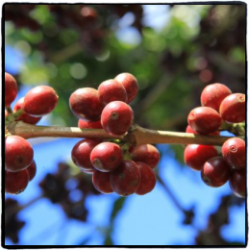Pearl adzuki bean African Jilimaza water wash bourbon Tanzania Kilimanjaro boutique coffee
Boutique coffee is fresh coffee. Whether it's food or drink, of course, the fresh the better, and so is boutique coffee. High-quality coffee should keep the coffee beans fresh before making, including the preservation of baked beans, and grind the coffee beans into powder before making, which is also to retain its original and best flavor. The way of making hand-brewed coffee is such a way to make high-quality coffee, and it is also one of the coffee-making methods that can best retain the original flavor of coffee. Boutique coffee is good coffee and is harmless to health. Different from coffee made with low-quality coffee beans, high-quality coffee uses high-quality coffee beans and freshly made coffee, which is harmless to health, and drinking in moderation is beneficial to the body and mind.
The coffee producing areas of Tanzania are Moshi, Mbeya and other producing areas around the foothills of Kilimanjaro in the north, and the Songea-Ruvuma area where the Ruvuma river flows to the south. The style is slightly different due to the different growth topography. The coffee produced in the Ruvuma region of southwestern Tanzania has wine and fruit aromas, which is different from that in the north near Mount Mt Kilimanjaro.
Mount Kilimanjaro is in the northeast of Tanzania, the largest coffee producing area in Tanzania, which accounts for 75%. In general, coffee beans in Tanzania have extraordinary quality. The important producing areas are in the mountains near Kenya in the north. Coffee farmers grow coffee 85% of the total, while local coffee farmers grow coffee at an altitude of 1300-2000m. Its coffee flavor is different from that of neighboring Ethiopia and Kenya. It has two national characteristics, thick body, good fruit and flower aroma, so it is worth a try. Coffee belongs to dicotyledonous plants. Generally speaking, there are two pairs of coffee seeds in a coffee cherry fruit, which is what we call coffee beans. Compared with pair of flat-sided beans, also known as caracol or caracolillo, it means little snail in Spanish. The production of round beans, botanically, is said to be due to uneven pollination (Arabica coffee is a self-pollinating plant, and if a coffee flower has only one ovary or only one ovary has successfully pollinated, it can only produce one seed). Or uneven nutrition during growth (usually more likely to occur in the coffee fruit growing at the end of the coffee tree), the nutrients are absorbed by only one of the cotyledons Only the cotyledons that get the nutrients and continue to grow grow into a single oval, oval-shaped coffee seed, hence the name of the round bean. Normally, the proportion of round beans produced by coffee plants is about 3 to 5%, which is relatively rare, and because the shape and size of coffee beans are different from those of normal coffee (flat) beans, round beans are often singled out and sold independently.

Important Notice :
前街咖啡 FrontStreet Coffee has moved to new addredd:
FrontStreet Coffee Address: 315,Donghua East Road,GuangZhou
Tel:020 38364473
- Prev

Introduction to the Lutesilo producing area of the western province of Rwanda, which is mostly grown by bourbon.
Rwanda has been growing coffee since colonial times. Although the crops are mainly coffee, the quality of coffee produced in Rwanda is not outstanding, and its status in the coffee world is low, and few people pay attention to it. Most of the coffee varieties grown in Rwanda are bourbon. Rwanda, known as the country of Thousand Hills, has a high-altitude mountain environment, fertile volcanic soil and abundant precipitation.
- Next

Introduction to the flavor and taste of Tanzania's pure and fragrant Kilimanjaro coffee
Coffee exports from Tanzania (Tanzania) play an important role in the whole national economy. In the past, the coffee industry in Tanzania has been dominated by manor cultivation, but now more than 85% are grown by small farmers. Many small farmers form cooperative organizations, the most important of which is the Kilimanjaro Cooperative Alliance (KilimanjaroCooperativeUnion, referred to as KNCU)
Related
- Does Rose Summer choose Blue, Green or Red? Detailed explanation of Rose Summer Coffee plots and Classification in Panamanian Jade Manor
- What is the difference between the origin, producing area, processing plant, cooperative and manor of coffee beans?
- How fine does the espresso powder fit? how to grind the espresso?
- Sca coffee roasting degree color card coffee roasting degree 8 roasting color values what do you mean?
- The practice of lattes: how to make lattes at home
- Introduction to Indonesian Fine Coffee beans-- Java Coffee producing area of Indonesian Arabica Coffee
- How much will the flavor of light and medium roasted rose summer be expressed? What baking level is rose summer suitable for?
- Introduction to the characteristics of washing, sun-drying or wet-planing coffee commonly used in Mantenin, Indonesia
- Price characteristics of Arabica Coffee Bean Starbucks introduction to Manning Coffee Bean Taste producing area Variety Manor
- What is the authentic Yega flavor? What are the flavor characteristics of the really excellent Yejasuffi coffee beans?

